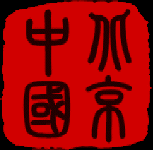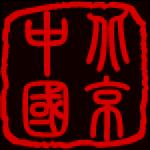|
Our selection from the many thousands of museums and art galleries in Beijing.
 National Museum of China 中国国家博物馆 National Museum of China 中国国家博物馆
The National Museum of China is a striking four-storied building that extends more than 300 meters along the eastern side of Tian'AnMen Square, facing the Great Hall of the People on the other side of the Square. It subsumes two museums: the Museum of Chinese History and the Museum of Chinese Revolution, that previously shared the same building complex.
The building was one of ten famous architectures built in 1959 to mark the 10th anniversary of the founding of the People's Republic. The Museum of Chinese History was in the South Wing while the North Wing housed the Museum of the Chinese Revolution. They were both opened to the public in 1961. The classical style building has a central courtyard and twenty-four pillars form the magnificent west gate portico.
Open: 9:00-4:00
 Capital Museum 首都博物馆 Capital Museum 首都博物馆
This museum pays tribute to Beijing life in bygone eras. With a floor area of more than 60,000 square meters, the Capital Museum is second only to the National Museum of China in terms of size. To see all the exhibitions in the new museum would take at least half a day.
There are well over 5,000 items on display, from a collection of 200,000 relics, plus archive photos of old Beijing and a collection of bronze statues on the top floor. The museum also features a cultural and museum activity area; activities include pottery making, a presentation showing how relics are repaired and preserved, and face-painting, Peking Opera style.
There is a digital movie hall with presentations every half hour. Designed much like an omni-theater, the arc-shaped screen presents a wide viewing angle of 120 degrees.
Open: 9:00 to 5:00
Address: 16 FuXingMenWai DaJie 复兴门外大街16号
 National Museum of Art 中国美术馆 National Museum of Art 中国美术馆
This museum is focused on displaying, collecting and researching the works of the artists in contemporary China. It was constructed in 1959.
The museum covers an area of 30,000 square meters of which 6,000 square meters are exhibition halls; it is the largest art museum in China.
There are 13 exhibition halls in the museum that display both permanent and temporary exhibitions, including international visits.
The art museum has collected more than 60,000 contemporary items of both fine art and folk art. The variety includes excellent examples in different styles, such as Chinese paintings, canvases, prints, sculptures, Spring Festival pictures, posters, sketches, iconography and watercolors. The collection also includes folk arts such as puppets, paper-cuts, kites, toys and embroidery.
Address: 1 WuSi Dajie, WangFuJing 五四大街1号
Open: 9:00-4:00, closed on Mondays
 World Art Museum 中华世纪坛世界艺术馆 World Art Museum 中华世纪坛世界艺术馆
Situated inside the Millenium Monument, this museum specializes in collecting, exhibiting and researching international arts. By collaborating with art museums and educational institutions worldwide, it strives to acquaint local people with broader human civilization and promote art and culture education. Displays changing major exhibitions from around the globe.
Open: 8:30-5:00
Address: 9A Fuxing Lu (Military Museum subway station) 复兴路甲9号
 Millenium Monument 中华世纪坛 Millenium Monument 中华世纪坛
The China Millennium Monument is China's commemorative building to welcome the year 2000, celebrating 5,000 years of history and hope for the future. The Monument is a grand structure that ingeniously combines the spirit of traditional Chinese culture with modern architectural design. It has both indoor and outdoor exhibition space.
Inside the southern entrance to the Monument is the Plaza of Holy Fire, one metre below ground and 960 square metres in area, standing for China' s vast territory of nearly 10 million square kilometres. As one approaches the Monument, the ground gently rises, suggesting the rise of the Chinese nation. In the center, the Holy Fire of China burns unceasingly, symbolizing the continuous creativity of the Chinese civilization.
At each side of the plaza is a steady current of water that begins by cascading down the steps of the Monument; this echoes the mother rivers of the Chinese nation: the YangTze and Yellow rivers.
Address: 9A Fuxing Lu (Military Museum subway station) 复兴路甲9号
 The Imperial City Art Museum 皇城艺术馆 The Imperial City Art Museum 皇城艺术馆
The imperial city of Beijing was initially constructed during the early Ming Dynasty (around 1420). The imperial city wall is the second of the then four city walls; the first, innermost one being that around the forbidden city.
Inside the imperial city, were all the service departments, stores, temples and gardens. Tian'AnMen Gate, BeiHai Park, JingShan hill, the Imperial Ancestral Temple (now the Working People's Cultural Palace), Altar to the God of Land and Grain (now ZhongShan Park) were all situated inside the imperial city.
This relatively small museum opened in 2003. It aims to show the life and history of the Imperial City through the 400 years of the Ming and Qing dynasties. A large collection of artifacts are on display.
Address: Inside the ChangPu River Park (PuChangHe Park), between WangFuJing and Tian'AnMen, on the north side of Chang'An avenue 菖蒲河公园
Open: 9:00-4:00
 Science & Technology Museum 中国科技馆 Science & Technology Museum 中国科技馆
The museum opened in 1988 and covers an area of 40,000 square meters, of which 16,000 square meters is for exhibition halls. Lots of interactive content.
The Astro-Vision Theater, among the largest in the world, is one of the museum's major attractions; it employs state-of-the-art cinematography that makes viewers feel they are participating in actual events rather than seeing a film.
Address: No 1, BeiSanHuan Zhonglu (North 3rd Ringroad) 北三环中路1号
Open: 9:00-4:30 (closed on Mondays but open during national holidays)
 Beijing Planetarium 北京天文馆 Beijing Planetarium 北京天文馆
The planetarium itself, with a dome that is 23.5 meters in diameter, is the main focus of interest of the entire complex. At regular intervals, a 45 minute presentation take the visitor on a trip through the cosmos, using projectors at the center of the hall.
In the courtyard are two astronomical observatories, one of which is equipped with a large telescope measuring 13 centimeters in diameter. Visitors can observe the moon, planets and stars with this telescope. On the west side of the planetarium is the Astronomy Square with more observation apparatus for visitors.
Address: 138 XiZhiMen WaiDajie 西直门外大街138号
Open: 9:30-4:00 Closed Mondays and Tuesdays
 Ancient Observatory 古观象台 Ancient Observatory 古观象台
The Ancient Observatory is a 17m tall, turreted tower once set in the outer city wall. Dating from the Yuan dynasty but reconstructed in 1442, it now displays bronze astronomical instruments from the Ming Dynasty (1368-1644), such as celestial globe, sundial and rotary star dial. Below the observatory are three halls with exhibitions detailing the astronomical achievements in ancient China, including epigraphs from emperors KangXi (1654-1722) and QianLong (1735-1795) of the Qing Dynasty (1644-1911).
One notable treasure here is a stone-carved star map from SuZhou dated 1247 (Song dynasty). It depicts 1,434 stars and is widely recognized as one of the very best early star maps in the world.
Another treasure is the ceiling astronomical map from LongFu Temple. Though dating from the Ming period, from the characters carved on the side of the map it is clear that the underlying information was known during the Tang dynasty.
In the courtyard, surrounded by ancient trees, are exhibits of early astronomical instruments, and the methods used and changes in their construction. Early methods of creating calendars are also described. Both ancient and more recent astronomical water clocks and contemporary clocks are also exhibited.
Address: 2 DongBiaoBei Hutong, JianGuoMen WaiDajie (next to JianGuoMen subway station, south west exit) 建国门外大街东裱褙胡同2号
Open: 9:00-4:30
 Museum of Natural History 自然博物馆 Museum of Natural History 自然博物馆
This large museum has a large collection of fossils and exhibitions detailing the natural world from prehistory to the present, including human evolution.
The museum has three main functions: the collection of specimens (currently 200,000 items), academic research, and the popularisation of paleontology, zoology, botany and anthropology.
Address: 126 TianQiao South Street (close to the west gate of the Temple of Heaven) 崇文区 天桥南大街 126号
Open: 8:30-4:30 (closed on Mondays)
 China Great Wall Museum 中国长城博物馆 China Great Wall Museum 中国长城博物馆
The museum, which covers 3,000 square meters, documents both the creation and development of the Great Wall and its current status. The museum has a special design. Walkways inside wind just like the Great Wall itself; there are even mountain passes and beacon towers.
The exhibition is composed of seven parts: the Great Wall of past dynasties, the Great Wall of Ming Dynasty (the wall we see today), construction equipment, battles on the Great Wall, economic and cultural exchange, the treasury of national art, and 'love China, repair the Great Wall'.
Address: BaDaLing Great Wall (west side of the pass, near the 901 bus stop)
Open: 9:00-4:30
 Military Museum 中国人民革命军事博物馆 Military Museum 中国人民革命军事博物馆
The museum occupies a total area of 60,000 square meters. The central exhibition hall contains over 500 photographs and more than 1,000 mementos of the communist revolution led by Mao ZeDong over the course of half a century. The outdoor plazas on either side of the central hall exhibit representative weapons used by the People’ s Liberation Army and weapons captured from the enemy during various periods of the revolutionary war.
On the eastern side of the main building, the three floors are taken up by specialized halls. The exhibits in these three halls depict the 28 years from the founding of the Chinese Communist Party in 1921 to the establishment of the People's Republic of China in 1949.
The first floor is devoted to the Second Revolutionary Civil War (1927-1937), the second floor to the War of Resistance Against Japan (1937-1945) and the third floor to the Third Revolutionary Civil War (1945-1949). They cover the organization of the Party and the army, the establishment of rural revolutionary bases and the seizure of state power by the armed forces and include more than 5,000 exhibits.
In the western wing, the first floor exhibition hall contains a general exhibition while the second and third floors house a display entitled 'The Protection of the Socialist Revolution and Construction'.
Address: 9 FuXing Lu (Military Museum subway station, line 1) 复兴路 9号
(军事博物馆 地铁站下车)
Open: 8:00-4:00
 China Space Museum 中华航天博物馆 China Space Museum 中华航天博物馆
China Space Museum demonstrates the great achievements of the country's space technology. It is also a base for scientific popularisation and patriotic education.
China Space Museum has a three-level exhibition hall, in which the first and second level are open to the public. The displays include carrier rockets, manned spacecraft, satellites and moon exploration apparatus. There is also an introduction to the space industry, and its history and future development in China.
Address: Inside China Carrier Rocket Technology Research Institution, 1 South DaHongMen, FengTai district 丰台区 大红门南 1号
Open: 8:00-5:00 Monday-Friday
 China Agricultural Museum 中国农业博物馆 China Agricultural Museum 中国农业博物馆
Indoor and outdoor exhibits of the historical development of agriculture in China and current research. Topics include tools, grains, plants and farming methods, from Neolithic times to the present day. Includes fascinating portrayals of rice cultivation and growing bamboo.
Covering 7,600 square meters, the China Agriculture Museum is split into three separate halls. The first contains the main exhibitions, of agricultural science & technology and water resources. The second and third halls include live animals.
Address: 16 DongSanHuanBei Road (east third ring north road), ChaoYang District 朝阳区 东三环北路 16号
Open: 9:00-4.00; closed on Mondays
 China Railway Museum 中国铁道博物馆 China Railway Museum 中国铁道博物馆
This is a wonderful museum to see first-hand the evolution of railway technology, from the first ever steam engine to the Mao ZeDong Train. The site includes 40 trains.
Address: No.1 Courtyard, JiuXianQiao North Road, ChaoYang District 朝阳区酒仙桥北路一号院
Open: 9:00-4:00 (closed on Mondays)
|



